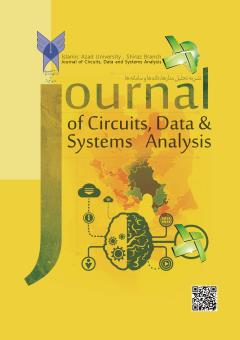ناحیه بندی تصاویر مغز نوزادان بر اساس شبکه های عصبی پیچشی
الموضوعات :
ایران سرافراز
1
,
حامد آگاهی
2
,
آذر محمودزاده
3
![]()
1 - دانشگاه آزاد اسلامی واحد شیراز
2 - دانشگاه آزاد اسلامی واحد شیراز
3 - گروه مهندسی برق، واحد شیراز، دانشگاه آزاد اسلامی، شیراز، ایران
الکلمات المفتاحية: ناحیه بندی, تصاویر رزونانس مغناطیسی, مغز نوزادان, شبکه های عصبی پیچشی, یادگیری عمیق,
ملخص المقالة :
در این مقاله، روشی مبتنی بر شبکه های عصبی پیچشی برای ناحیه بندی تصاویر مغز نوزادان ارائه می شود. یکی از چالش های مهم در ناحیه بندی تصاویر مغز نوزادان، همپوشانی توزیع شدت روشنایی بافت های ماده خاکستری و ماده سفید است که منجر به کاهش دقت ناحیه بندی این نواحی می شود. برای افزایش تمایز سطوح خاکستری بین بافت های مغز، در این مقاله یک روش پیش پردازش مبتنی بر شبکه های عصبی پیچشی ارائه می شود که به طور موثری باعث افزایش دقت ناحیه بندی می گردد. برای به دست آوردن نتیجه نهایی ناحیه بندی، یک شبکه پیچشی دیگر ارائه می شود که بر اساس تصاویر مدالیتی T1-T2ناحیه بندی را انجام می دهد. برای ارزیابی روش پیشنهادی، از دو پایگاه داده که شامل تصاویر رزونانس مغناطیسی مغز نوزادان است استفاده می شود. نتایج به دست آمده نشان دهنده کارایی مناسب روش پیشنهادی در ناحیه بندی بافت های مغز است.
[1] G. Li, et al., Mapping Region-Specific Longitudinal Cortical Surface Expansion from Birth to 2 Years of Age, Cerebral Cortex, vol. 23, pp. 2724-2733, Nov 2013.
[2] L. Wang, et al., Segmentation of Neonatal Brain MR Images Using Patch-Driven Level Sets, NeuroImage, vol. 84, pp. 141-158, Jan 1, 2014.
[3] L. Wang, et al., Links: Learning-Based Multi-Source Integration Framework for Segmentation of Infant Brain Images, NeuroImage, vol. 108, pp. 160-72, Mar 2015.
[4] F. Shi, et al., Neonatal Atlas Construction Using Sparse Representation, Human Brain Mapping, vol. 35, pp. 4663-4677, Sep 2014.
[5] F. Shi, et al., Construction of Multi-Region-Multi-Reference Atlases for Neonatal Brain MRI Segmentation, NeuroImage, vol. 51, pp. 684-693, Jun 2010.
[6] Devi, C. N., et al., Automatic segmentation of infant brain MR images: With special reference to myelinated white matter, Biocybernetics and Biomedical Engineering, vol. 37, no. 1, pp. 143-158, 2017.
[7] G. Li, et al., Computational Neuroanatomy of Baby Brains: A Review, NeuroImage, vol. 185, pp. 906-925, 2018.
[8] George, M. M., et al., A view on atlas-based neonatal brain MRI segmentation. ICTMI 2017, pp. 199-214, 2019.
[9] Mostapha, M. et al., Role of deep learning in infant brain MRI analysis. Magnetic resonance imaging, vol. 64, pp.171-189, 2019.
[10] Wu, Z., et al, Construction of 4D infant cortical surface atlases with sharp folding patterns via spherical patch‐based group‐wise sparse representation, Human brain mapping, vol. 40, no. 13, pp. 3860-3880, 2019.
[11] Iclănzan, D., et al., The role of atlases and multi-atlases in brain tissue segmentation based on multispectral magnetic resonance image data. In 2021 IEEE AFRICAN, pp. 1-6, 2021.
[12] Wang, J., et al., Multi-atlas segmentation of subcortical brain structures via the AutoSeg software pipeline, Frontiers in neuroinformatics, vol. 8, pp. 7-15, 2014.
[13] Dong, P., et al., Multi-atlas and multi-modal hippocampus segmentation for infant MR brain images by propagating anatomical labels on hypergraph, In International Workshop on Patch-based Techniques in Medical Imaging Springer, pp. 188-196, 2015.
[14] Puonti, O., Iglesias, J.E. and Van Leemput, K., Fast and sequence-adaptive whole-brain segmentation using parametric Bayesian modeling. NeuroImage, Vol. 143, pp. 235-249, 2016.
[15] Makropoulos, A., Counsell, S.J., Rueckert, D., A review on automatic fetal and neonatal brain MRI segmentation. NeuroImage, Vol. 170, pp. 231-248, 2018.
[16] Guo, Y., Wu, Z. and Shen, D., Learning longitudinal classification-regression model for infant hippocampus segmentation. Neurocomputing, Vol. 391, pp.191-198, 2020.
[17] Dolz, J., Desrosiers, C., Wang, L., Yuan, J., Shen, D. and Ayed, I.B., Deep CNN ensembles and suggestive annotations for infant brain MRI segmentation. Computerized Medical Imaging and Graphics, Vol. 79, p.101660, 2020.
[18] Bui, T.D., Shin, J. and Moon, T., Skip-connected 3D DenseNet for volumetric infant brain MRI segmentation. Biomedical Signal Processing and Control, 54, p.101613, 2019.
[19] Chen, Y., Qin, Y., Jin, Z., Fan, Z. and Cai, M., A Triple Residual Multiscale Fully Convolutional Network Model for Multimodal Infant Brain MRI Segmentation. KSII Transactions on Internet and Information Systems (TIIS), Vol. 14, pp.962-975, 2020.
[20] Qamar, S., Jin, H., Zheng, R., Ahmad, P. and Usama, M., A variant form of 3D-UNet for infant brain segmentation. Future Generation Computer Systems, Vol. 108, pp.613-623, 2020.
[21] Karayegen, G. and Aksahin, M.F., Brain tumor prediction on MR images with semantic segmentation by using deep learning network and 3D imaging of tumor region. Biomedical Signal Processing and Control, Vol. 66, p.102458, 2021.
[22] Pasban, S., Mohamadzadeh, S., Zeraatkar-Moghaddam, J. and Shafiei, A.K., Infant brain segmentation based on a combination of VGG-16 and U-Net deep neural networks. IET Image Processing, Vol. 14, pp.4756-4765, 2021.
[23] Wang, L., Nie, D., Li, G., Puybareau, É., Dolz, J., Zhang, Q., Wang, F., Xia, J., Wu, Z., Chen, J.W. and Thung, K.H., Benchmark on automatic six-month-old infant brain segmentation algorithms: the iSeg-2017 challenge. IEEE transactions on medical imaging, Vol. 38, pp.2219-2230, 2019.
[24] Sun, Yue, Kun Gao, Zhengwang Wu, Guannan Li, Xiaopeng Zong, Zhihao Lei, Ying Wei. Multi-site infant brain segmentation algorithms: The iSeg-2019 Challenge. IEEE Transactions on Medical Imaging Vol. 5, pp. 1363-1376, 2021.
[25] Diederik P. Kingma and Jimmy Lei Ba. Adam: A method for stochastic optimization. arXiv:1412.6980v9, 2014.
[26] Good, I. J. Rational Decisions. Journal of the Royal Statistical Society. Series B (Methodological), vol. 14, no. 1, pp. 107–114, 1952.


